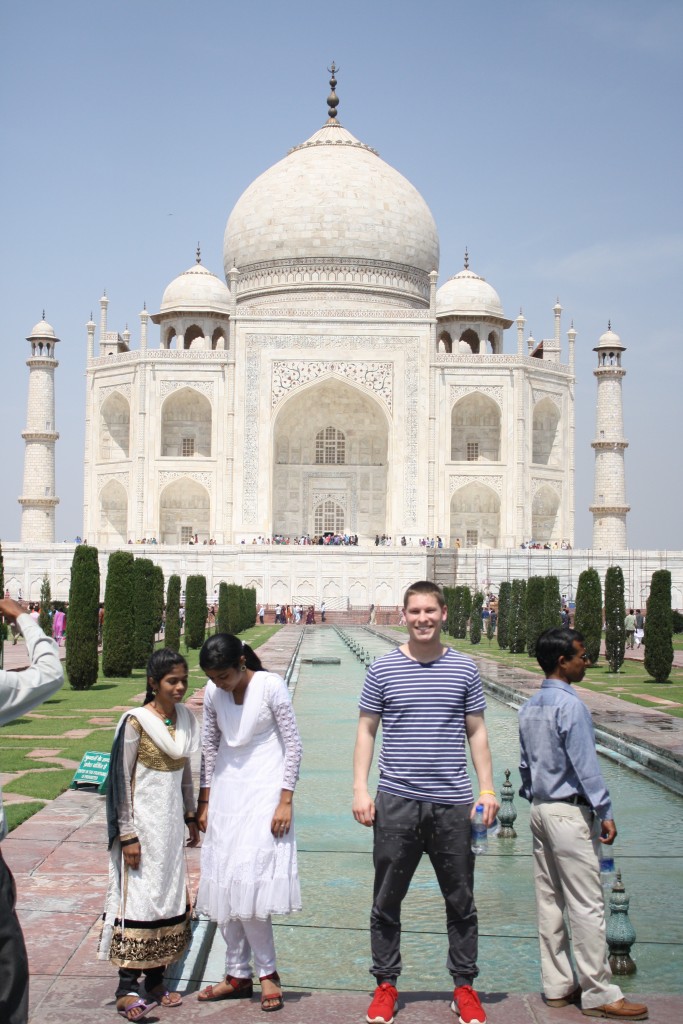Other Localized Supply Chains: Observations from an Auto Plant Tour
By Daniel Bodemer and Cody Williams, Supply Chain Management students at the University of Illinois at Urbana-Champaign
The following post was written by students on an ADM Institute-sponsored observation study tour through India in March 2015.

During their trip to India, Dan (pictured above at the Taj Mahal) and Cody got the chance to see how classroom concepts apply in a real-world, international setting. Credit: ADMI/K.Wozniak
We spent the first six days of our trip learning about postharvest loss and the culture of India. Our last day, we switched gears again and got yet another perspective of how economies function in the large country. We visited an auto manufacturing plant in Gurgaon operated by Maruti-Suzuki Auto, a joint venture between Maruti Udyog of India and Suzuki of Japan that began in 1983 and today is one of the largest auto manufacturers headquartered in India. What we learned about their manufacturing practices surprised us, and gave us new insights about the industrial side of India.
Maruti Suzuki is committed to a “localized” supply chain. 95% of their 393 Tier 1 suppliers are located in India, with 80% of those located 75 km or less from the plant. This practice allows faster lead times which establishes their just-in-time practice. Other benefits of this “localized” supply chain include low holding costs as a result of Maruti holding only one week’s worth of components at a time. They also have great confidence in their suppliers. They only have one supplier for each component that goes into producing their automobiles. Overall 75% of the value of each automobile they produce comes from sourced components.
The plant is open six days a week with Sundays set aside for safety inspections. Throughout our tour of the plant, signs promoting safety and environmental consciousness were evident everywhere. We were pleasantly surprised by this commitment to safety and the environment, considering the stigma developing countries such as India have as a place where companies go to escape the tougher safety and environmental regulations of Europe and the United States.
We learned that Maruti-Suzuki was the first passenger car company in India to get certified for Environment Management System as per ISO:14001 in 1999. Maruti-Suzuki is so committed to improving the environment and leaving a smaller carbon footprint that they made it mandatory for all of their Tier 1 suppliers to also be ISO:14001-certified by March 31, 2015.
We met with the plant’s vice president of supply chain, who has been with Maruti-Suzuki from the very beginning. He answered our questions regarding the ever-changing supply chain and changing customer demands. We were very surprised about the different standards in India compared to the United States. For instance, anti-lock brakes were not introduced until 1997, and even in 2015, airbags are only available in higher-end models.
Maruti-Suzuki has recognized an increase in demand for their automobiles worldwide, which is why they’ve been able to drastically increase their production capacity at the plant in Gurgaon with a new production facility planned in the next 3 years.
Overall, the visit to the auto plant showed us the growing industrial side of India and helped erase the stigma that India has for low quality, safety and environmental manufacturing standards.
Dan and Cody were participants in the 2015 Supply Chain Management India study abroad trip organized by the program director in the College of Business at the University of Illinois at Urbana-Champaign, Professor Udatta Palekar. Throughout the 10-day trip, students observe how agricultural products in India move through supply chains from farm to consumer with a special focus on postharvest losses.
Read more blogs in this series:
Hearing from locals on farming in south India: Day 1
Things are heating up in India: Day 2
Commissioner commentary: Day 6
Farming systems in north vs. south India: Day 7
Reflection on stepping out of our comfort zones



Add Comment